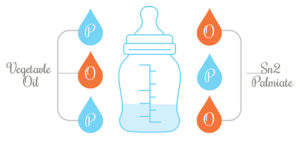The Gold Standard – How We Imitate Mother’s Milk
They say that imitation is the sincerest form of flattery and we’re not ashamed to say that we want to help manufacturers copy Mother’s Milk as closely as possible.
Human breast milk is the gold standard towards which every formula brand should strive. There is no doubt that it provides the optimal nutrition for infants, delivering a perfect balance of nutrients that naturally meets every need in the first months of life. In a world where breast-feeding isn’t always possible, it’s vital that formula manufacturers come as close as they possibly can to the real thing.
One area where we have seen significant innovation recently is the replication of the prebiotics found in mother’s milk. These substances support “good bacteria” in the gut and include HMOs (Human Milk Oligosaccharides), which are more than 100 times more abundant in human milk than cow’s milk. A recent study showed that babies fed formula containing a structurally identical version of an HMO had an immune system response more like breastfed babies.

Another major breakthrough has been in the way fat is used in formula. Fat comprises about 26% of dry breast milk and provides the new-born with half the energy he or she needs for proper growth and development. Most infant formula manufacturers now use vegetable fat in their formula, but this is still very different from the fat found in breast milk. The main reason for the difference is the unique structure of the fat in human milk. Both human milk and vegetable oil are triglycerides, which means that they are comprised of different fatty acids attached to a glycerol backbone. However, there is a very major difference between them.
 Most (70-75%) of the palmitic acid in human milk is attached to the glycerol backbone in a position known as sn2 (also known as sn2 palmitate, beta-palmitate, or OPO.) By contrast, only 8-10% of their palmitic acid in vegetable oils is attached in the second position. An indicator of the importance of sn2 palmitate is that it is found in the breast milk of all women, regardless of their ethnic origin or diet.
Most (70-75%) of the palmitic acid in human milk is attached to the glycerol backbone in a position known as sn2 (also known as sn2 palmitate, beta-palmitate, or OPO.) By contrast, only 8-10% of their palmitic acid in vegetable oils is attached in the second position. An indicator of the importance of sn2 palmitate is that it is found in the breast milk of all women, regardless of their ethnic origin or diet.
So while the addition of vegetable oil into milk formula was hugely important, the development of sn2 palmitate from vegetable sources was nothing less than a game-changer. By mimicking the fatty acid positioning of human milk, it delivers many of the same benefits.
INFAT® is Advanced Lipids’ clinically tested OPO fat ingredient. In clinical studies that compared infant formula containing INFAT® to standard formula, INFAT® was found to improve comfort, support healthy growth and enhance immunity.
As a clinically tested OPO component, therefore, INFAT® allows manufacturers to offer products that deliver many of the benefits of human milk. Nothing will ever replace the Gold Standard of Mother’s Milk, but the more we innovate the closer we get.
Back to Blog